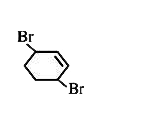What is the final product of the following reaction sequence?
Cyclohexanol (i)conc.H2SO4/Δ(ii)NBS/CCl4/hv−−−−−−−−−−−−−−−→(iii)AlcKOH/Δ(iv)Br2/40∘C




The correct Answer is:D
To determine the final product of the given reaction sequence starting from cyclohexanol, we will analyze each step of the reaction:
Step 1: Dehydration of Cyclohexanol
- Reaction: Cyclohexanol is treated with concentrated sulfuric acid (H₂SO₄) and heated.
- Mechanism: The hydroxyl group (-OH) of cyclohexanol is protonated by H₂SO₄, forming an oxonium ion. This ion is unstable and loses a water molecule (H₂O), resulting in the formation of a carbocation. The most stable carbocation is formed, which is a secondary carbocation in this case.
- Product: The carbocation then loses a hydrogen ion (H⁺) to form cyclohexene (C₆H₁₁).
Step 2: Bromination using NBS
- Reaction: Cyclohexene is treated with N-bromosuccinimide (NBS) in the presence of carbon tetrachloride (CCl₄) and light (hv).
- Mechanism: NBS generates bromine radicals (Br•) under light. The double bond in cyclohexene reacts with the bromine radical to form an allylic radical. This radical can stabilize through resonance.
- Product: The allylic radical then reacts with Br• to form allylic bromide (1-bromo-cyclohexene).
Step 3: Elimination with Alcoholic KOH
- Reaction: The allylic bromide is treated with alcoholic potassium hydroxide (KOH) and heated.
- Mechanism: KOH acts as a base and abstracts a proton from the carbon adjacent to the bromine, leading to the elimination of HBr and formation of a conjugated diene.
- Product: The product is a conjugated diene (cyclohexadiene).
Step 4: Bromination of the Conjugated Diene
- Reaction: The conjugated diene is treated with bromine (Br₂) at 40°C.
- Mechanism: The π electrons of the diene attack bromine, leading to the formation of a bromonium ion intermediate. The bromide ion then attacks the more stable position (due to resonance), leading to the formation of a dibrominated product.
- Product: The final product is 1,4-dibromocyclohexene, which is a thermodynamically controlled product.
Final Product
The final product of the reaction sequence is 1,4-dibromocyclohexene.
---
- Reaction: Cyclohexanol is treated with concentrated sulfuric acid (H₂SO₄) and heated.
- Mechanism: The hydroxyl group (-OH) of cyclohexanol is protonated by H₂SO₄, forming an oxonium ion. This ion is unstable and loses a water molecule (H₂O), resulting in the formation of a carbocation. The most stable carbocation is formed, which is a secondary carbocation in this case.
- Product: The carbocation then loses a hydrogen ion (H⁺) to form cyclohexene (C₆H₁₁).
- Reaction: Cyclohexene is treated with N-bromosuccinimide (NBS) in the presence of carbon tetrachloride (CCl₄) and light (hv).
- Mechanism: NBS generates bromine radicals (Br•) under light. The double bond in cyclohexene reacts with the bromine radical to form an allylic radical. This radical can stabilize through resonance.
- Product: The allylic radical then reacts with Br• to form allylic bromide (1-bromo-cyclohexene).
- Reaction: The allylic bromide is treated with alcoholic potassium hydroxide (KOH) and heated.
- Mechanism: KOH acts as a base and abstracts a proton from the carbon adjacent to the bromine, leading to the elimination of HBr and formation of a conjugated diene.
- Product: The product is a conjugated diene (cyclohexadiene).
- Reaction: The conjugated diene is treated with bromine (Br₂) at 40°C.
- Mechanism: The π electrons of the diene attack bromine, leading to the formation of a bromonium ion intermediate. The bromide ion then attacks the more stable position (due to resonance), leading to the formation of a dibrominated product.
- Product: The final product is 1,4-dibromocyclohexene, which is a thermodynamically controlled product.
The final product of the reaction sequence is 1,4-dibromocyclohexene.
Similar Questions
Knowledge Check
- Question 1 - Select One
What is the final product of the following reaction sequence?
cyclohexanol overset((i) conc. H_2 SO_4//Delta ) overset((ii) NB S//C Cl_4 //hv)underset((iv) Br_2//40^@ C) underset((iii) Alc KOH//Delta ) toA B
B C
C D
D
- Question 2 - Select One
The major product of the following reaction
 (1)tBuOK−−−−−−−−−−−−→(2)Conc.H2SO4/ΔA
(1)tBuOK−−−−−−−−−−−−→(2)Conc.H2SO4/ΔA B
B C
C D
D
- Question 3 - Select One
What is the final product of the following reaction sequence?
(CH3)3C−C≡C−H(i)dil.H2SO4/HgSO4−−−−−−−−−−−−−−→(ii)NaBH4/ethanol(iii) dil . acidA(CH3)3C−OH∣CHCH3B(CH3)3−CH=CH2C(CH3)2C=C(CH3)2D(CH3)3C−CH2−CH2OH
The final product of the following reaction is

COCH3Δ−−→BrCl/CCl4−−−−−−→View SolutionThe final product (Y) of the following reaction is:
C2H4Br2−−→XPd/H2−−−→YView SolutionThe major product of the following reaction is :

(i)NaNO2/H+−−−−−−−−−−−−→(ii)CrO3/H+(iii)H2SO4(conc.),ΔView SolutionThe end product (C) in the following reaction sequence is
CH3CH2COOHBr2.Red−−−−−−−→ΔAOH−(aq)/(→)BΔ−−→CView SolutionWhat is the product of the following reactions?
Me−Me∣C∣Me−C=CH(i)H2SO4/HgSO4(ii)NaBH4−−−−−−−−−−−→(iii)Conc.H2SO4(iv)O3ZnH2OView Solution


